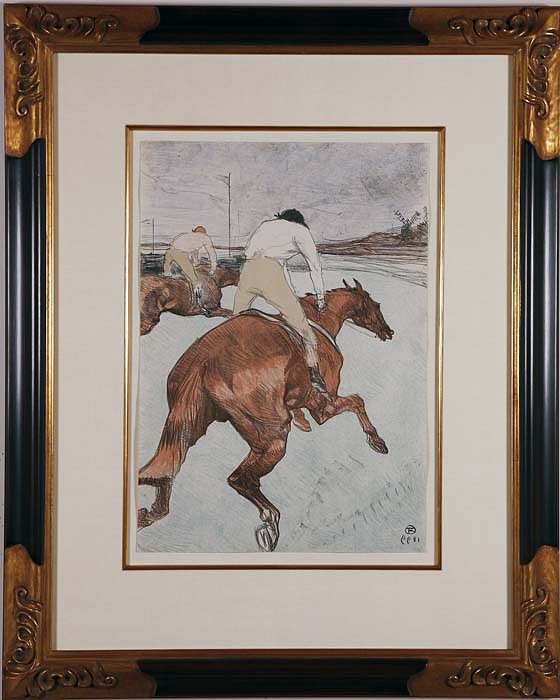PRESS RELEASE

The Circle of Toulouse-Lautrec
Apr 13 – Jul 31, 2012
Contessa Gallery is proud to present a group exhibition of works by some of the most celebrated artists in art history. Original works, fine art prints and highly collectible French antique posters will be on view April 13 - May 27, 2012.
The turning point of the 19th and 20th centuries was a revolutionary time in art history. While seemingly tame by today's standards, the Impressionists were breaking new ground and were considered cutting edge and even scandalous.Their followers, the artists of the Belle Epoque, continued their innovations. Among the many names that shined brightly at the turn of the century were Edgar Degas, Pierre-Auguste Renoir, Edouard Manet, James Jacques Tissot, and of course Henri de Toulouse-Lautrec. The exhibition at Contessa Gallery traces the development of art and fine printmaking through one of the most influential and beloved periods in art.
Radicals in their time, early Impressionists broke the rules of academic painting. While remaining realists in the sense that they remained true to their sensations of the object, they ignored many of the old conventions for representing the object. Their truthfulness lay in their personal and subjective sensations, not in the "exact" reproduction of an object for its own sake. Employing drastically new methods of applying color, the Impressionists strove to capture a moment in time as a viewer's eye would see it. Their radical experiments with color and desire to break the rules of academic painting would forever influence modern art movements. For years they struggled for acceptance into the Salon and fine art galleries of their day, never knowing their work would one day become the most widely known, popular and beloved Schools of Art in history.
Their followers continued to break new ground in printmaking. La Belle Epoque was a time of extravagant self-indulgences by the upper class. There was a burst of inventions and new technology, which led to a vibrant street life. Moulin Rouge, the cabarets of the Montmartre and the concert-cafes along the boulevards were thriving. The otherwise gray and bleak streets of Paris were decorated, as if for a festival, with colorful advertising posters by some of the finest artists of the time. Renowned art connoisseurs and critics as well as people in the streets, were delighted by this new contemporary art. The artists considered the advertising poster the best way of exhibiting their talents to the widest public and thus, Paris became an open air museum and advertising posters became objects of art collecting.
Today vintage posters, as collectibles, carry a certain cachet, as rescued fragments of a lost past. Original authentic vintage posters are recognized as highly collectible by museums and prominent collectors due to their aesthetic value and rarity. Such distinguished institutions as the Louvre, the Metropolitan Museum of Art, the Museum of Modern Art and the Library of Congress have extensive French antique poster collections.
For a period of approximately ten years at the end of the 19th century, color lithography flourished in France as the prtinmaking medium most preferred by artists of the avant-garde. Much of this was prompted by the proliferation of print publications which were designed for the burgeoning collectors of the middle class. One of the last of these to appear was L'Estampe Moderne. The total publication included 98 prints by some of the most renowned printmakers of the avant-garde including Mucha, Steinlen, and Grasset. Each contains the "blindstamp" imprint of the series: a head of a young woman in the lower right corner.
Another influential publication in art history is called "Les Maitres de l'Affiche" (The Masters of the Poster), and features 256 color plates representing a wide-ranging selection of outstanding original prints from the turn of the 20th century, when this popular art form first reached its peak. The exhibition at Contessa Gallery will feature a number of examples from both series.
Many artists emerged during that time period, and while each had their own individual style, talent and creativity, they also learned from each other's achievements and successes. Among them, the boldest and most prominent was Henri de Toulouse-Lautrec, who created posters that reflected the bohemian culture and joie de vivre of Montmartre, often incorporating his notorious associates in the images. The son of an aristocratic and wealthy family in the South of France, he received recognition rather early in life. His lithographs showed the famous personalities of the French Belle Epoque - singers and dancers, writers, poets and actors. Japanese printmaking had a very strong influence on his style and can be witnessed in his compositions, unusual perspectives and the use of large areas of flat color. On view at Contessa Gallery will be several of his most prominent and rare lithographs, many of which became symbols of the era. The exhibition will also showcase many important original drawings and fine prints by such masters as Edouard Manet, Auguste Renoir, James Jacques Tissot, Edgar Degas, Mary Cassatt, Paul Cesar Helleu, Jules Cheret, Theophile Alexandres Steinlen, and James Whistler.
The exhibition will begin with opening receptions which will take place at Contessa Gallery (Legacy Village) on April 13 & 14th, 6 - 9 pm. Please R.S.V.P. if you would like to attend.
To arrange media interviews or to receive hi-res images of the works, please contact Steve Hartman at 216.382.7800 or via email art@contessagallery.com
